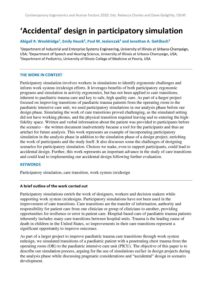| Document | Author Abigail R. Wooldridge, Emily Heuck, Paul M. Jeziorczak and Jonathan A. Gehlbach |
| Abstract Participatory simulation involves workers in simulations to identify ergonomic challenges and inform work system (re)design efforts. It leverages benefits of both participatory ergonomic programs and simulation in activity ergonomics, but has not been applied to care transitions, inherent to paediatric trauma care and key to safe, high quality care. As part of a larger project focused on improving transitions of paediatric trauma patients from the operating room to the paediatric intensive care unit, we used participatory simulations in our analysis phase before our design phase. Simulating the work of care transitions proved challenging, as the simulated setting did not have working phones, and the physical transition required leaving and re-entering the high-fidelity space. Written and verbal information about the patient was provided to participants before the scenario – the written document inadvertently became a tool for the participants and thus an artefact for future analysis. This work represents an example of incorporating participatory simulation in the analysis phase in addition to the simulation phase of a design project, enriching the work of participants and the study itself. It also discusses some the challenges of designing scenarios for participatory simulation. Choices we make, even to support participants, could lead to accidental design. Further, this work represents an important advance in the study of care transitions and could lead to implementing our accidental design following further evaluation. |

